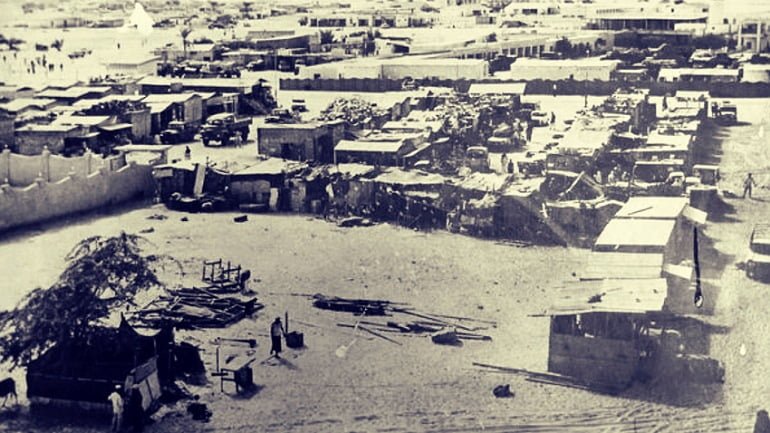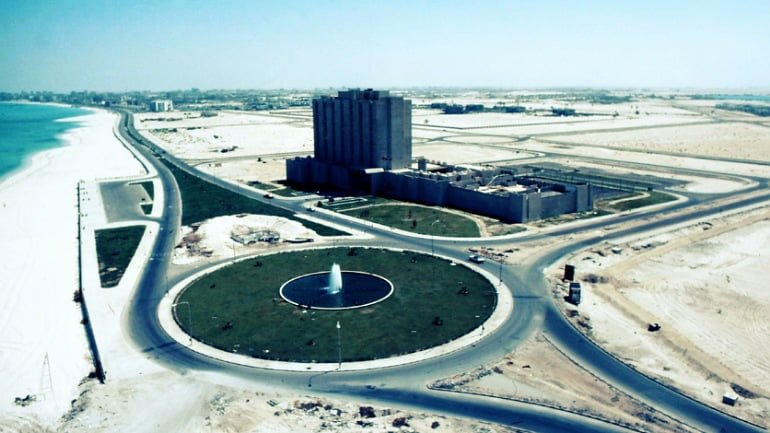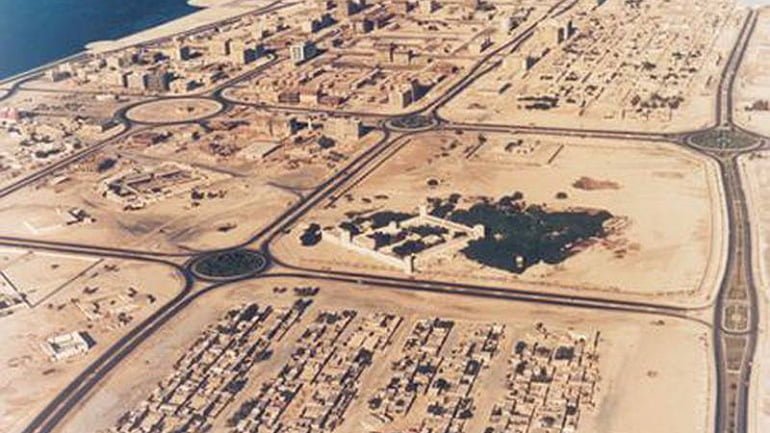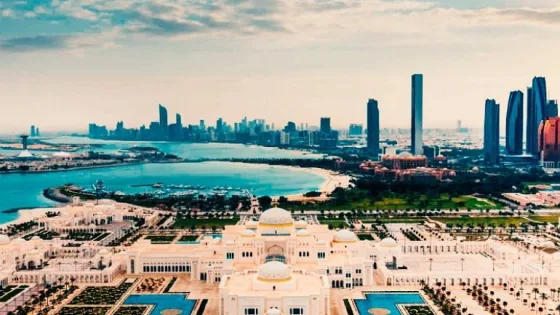Contents
The history of Abu Dhabi is rich and full of historical events over time so this ancient city underwent many changes until the city of Abu Dhabi became what it is today. You may have many questions in your mind, such as how old is the city of Abu Dhabi? How did this city originate? How was it before? Who is the first ruler of Abu Dhabi? What led to its transformation and flourishing to what it is today?
In our article, we will answer these questions and provide you with a lot of useful information about the natural history of Abu Dhabi.
brief history of abu dhabi/facts about Abu Dhabi city

Not so many people know about the history of abu dhabi or about abu dhabi is in which country. Abu Dhabi is the capital of the United Arab Emirates., and in 1761, the Baniyas tribe found drinking water on the remote island, which today is known as Abu Dhabi. But you will be very surprised when you know what the former name of the city of Abu Dhabi was. Before the city was named by this name, it was previously known as milh, which means salt in the Arabic language.
It is believed that this title was given to the city because of the salinity of the water in the area. And still, to this day, there is an island bearing this name. The name Abu Dhabi was first used goes back to 300 years ago meaning ‘Father of the gazelle’. The beginning ruling of Abu Dhabi belongs to the Al-Nahyan family, which is descended from the Bani Yas tribe. So Abu Dhabi traces its origins to the Bani Yas tribe.
You may also like: “UAE visa fees; how to apply, and all you need to know about it“
History of abu dhabi timeline

Many interesting historical events took place in the city of Abu Dhabi since its discovery from 1761 to this day. The following timeline shows the most important events that occurred in the city and the most important thing that happened to its land until it became one of the greatest Arab cities and enriched it with culture, civilization, and prosperity.
history of Abu Dhabi From 1761 to 1952
The bani yas tribe discover Abu Dhabi island and begin the settlement by uniting the regional tribes, at the hand of the sheikh of bani yas Shakhbut bin Dihyab bin Isa Al Nahyan. Later in 1790 become the ruler of Abu Dhabi, which became the capital of the bani yas tribal confederation in 1795. A general treaty of peace is signed between the British government and the rulers of Abu Dhabi, Dubai, Sharjah, Ajman, Ras Al Khaimah, and Fujairah.
In 1939 oil companies were allowed to start drilling and a petroleum company was established. A council is formed to ensure cooperation between the trucial states (the seven emirates).
1971 – 2010
On 2 December 1971, The crucial state became the United Arab Emirates. The founding father of the Uae, Sheikh Zayed bin Sultan Al Nahyan became the president of the union. The UAE Dirham and AED currency was launched in 1973. Then happened as the following:
- 1982 _ opened Abu Dhabi International Airport.
- 1996 _ Emirate of Abu Dhabi became the capital of UAE.
- 2007 _ Sheikh Zayed mosque was built.
- 2010 _ Ferrari world opened successfully.
Our pick for you: “UAE family visa: learn about it’s requirements, ways to apply, validity, and total price“
history of Abu Dhabi From 2010 until now
Many changes occurred in the city and the United Arab Emirates as a whole in these years. Abu Dhabi’s global market became fully operational in Oct 2015. New York University campus was built, Louvre Abu Dhabi was opened and Sheikh Mohammed bin Zayed Al Nahyan was formally selected as the president of the UAE in 2022. For the convenience of readers, in the following table, I will summarize each event with the time of its occurrence.
| 1761 | Bani yas tribe discover abu dhabi. |
| 1790 | Shakhbut bin Dihyab bin Isa Al Nahyan became the ruler of Abu Dhabi. |
| 1795 | Abu Dhabi became the capital of the bani yas tribal confederation. |
| 1939 | oil companies were allowed to start drilling and a petroleum company was established. |
| 1971 | The crucial state became the United Arab Emirates. |
| 1973 | The UAE Dirham and AED currency was launched. |
| 1982 | Abu Dhabi International Airport was opened. |
| 1996 | Emirate of Abu Dhabi became the capital of the UAE. |
| 2007 | Sheikh Zayed mosque was built. |
| 2010 | Ferrari world was opened. |
| 2015 | Abu Dhabi’s global market became fully operational. |
| 2022 | Sheikh Mohammed bin Zayed Al Nahyan was selected as the president of the UAE. |
Read also: “history of Dubai city: amazing factors you dont know before oil discovery vs current times“
Ways to discover the ancient history of Abu Dhabi

Despite the massive transformation that the city of Abu Dhabi has witnessed over the centuries until it has become modern and developed as well as increasing in abu dhabi population, we can still trace its rarest wonders of natural history. There are many ways that unveiled plans for the natural history of abu dhabi wikipedia, through the following:
- The city center itself is rich in historical monuments such as Qasr Al Hosn and Bani Yas settlement which is a natural history museum Abu Dhabi now.
- Meet artisans and learn about traditional crafts that bring together and enhance the relationship between local people and natural resources.
- Explore ancient treasures from the sea by boat. Pearling and fishing played a role in the economic boom.
- Wandering through walkways and oases like Al Ain oases which is a part of the heritage site.
- Explore picturesque forts such as Al Jahili forts and other places like Qasr Al Muwaiji and Sir Wilfred Thesiger.
- Learn about its history-making animals, such as camels, falcons, and Salukis.
Sir Bani Yas Island It was home to a church, a monastery, and its artifacts, allowing its inhabitants to trade across the Persian Gulf and the Indian Ocean.
another intersting article: “UAE golden visa: amazing benefits for obtaining it you may don’t know about”
It may intrest you: “Trading history of UAE: it’s importance, and the events that occured over time“
What is the history of Abu Dhabi?
Abu Dhabi is the capital city of the United Arab Emirates (UAE) and has a rich history that dates back over 5,000 years. The area was originally inhabited by nomadic tribes who lived off fishing, pearl diving, and trading. In the 18th century, Abu Dhabi became a center for trade and commerce due to its strategic location on the Persian Gulf.
In 1793, the Al Nahyan family established their rule over Abu Dhabi and began to expand their territory through alliances with neighboring tribes. The Al Nahyan family continued to rule Abu Dhabi throughout the 19th century and into the 20th century.
In 1939, oil was discovered in Abu Dhabi, which transformed the city into a major economic center. The discovery of oil led to rapid development and modernization of the city’s infrastructure, including roads, airports, hospitals, schools, and housing.
In 1971, Abu Dhabi joined with six other emirates to form the United Arab Emirates (UAE), with Abu Dhabi serving as its capital city. Since then, Abu Dhabi has continued to grow and develop into a global hub for business, tourism, culture, and innovation. Today it is home to some of the world’s most iconic landmarks such as Sheikh Zayed Grand Mosque and Ferrari World.
What did Abu Dhabi used to be called before?
Throught the history of Abu Dhabi we can find out that Abu Dhabi was previously known as Milh or Maill.
What is Abu Dhabi known for?
Abu Dhabi is known for its luxurious lifestyle, modern architecture, and rich cultural heritage. It is the capital city of the United Arab Emirates and is famous for its oil reserves, which have made it one of the wealthiest cities in the world. Abu Dhabi is also known for its stunning beaches, world-class shopping malls, and iconic landmarks such as the Sheikh Zayed Grand Mosque and the Emirates Palace Hotel. The city is also home to several museums and art galleries that showcase the region’s history and culture. Additionally, Abu Dhabi hosts several international events such as Formula 1 Grand Prix, Abu Dhabi Art Fair, and Abu Dhabi International Book Fair.
How did Abu Dhabi became rich?
Abu Dhabi became rich primarily due to its vast oil reserves. The discovery of oil in the 1950s transformed the economy of Abu Dhabi from a small fishing and pearl diving community to a wealthy city-state. The government invested heavily in infrastructure, education, healthcare, and other sectors to support economic growth. Abu Dhabi also attracted foreign investment and developed a diversified economy with industries such as finance, tourism, real estate, and construction. Additionally, the city-state has a favorable tax system that attracts businesses and entrepreneurs from around the world.
The greatness of the history of Abu Dhabi and the historical events that took place on its land, century after century, led to its transformation to a civilized city rich in culture and civilization that we are witnessing today, and is still in continuous development, preserving all the ancient monuments and archaeological sites that can be traced to the discovery and knowledge of the history of Abu Dhabi.











